Excursion to the atomic icebreaker-museum "Lenin"
On October 27, at the invitation of the Atomic Energy Information Center, he visited Murmansk, gave three lectures, watched the icebreaker-museum “Lenin” and the Naval Museum of the Northern Fleet. Under the cut a lot of photos.

After 30 years of operation and 563 thousand miles traveled by the first atomic icebreaker (and the first surface ship with a nuclear power plant), the corps has worn out, and now it works as a floating museum.

On the right, by the way, there is also an unusual ship — the Western Neptune bought by Sevmorneftegeofizika, a seismic surveyor and a research vessel.

The icebreaker was built at a fantastically fast pace — laid in 1956, launched in 1957, and in 1959 it went to sea trials. Despite this, they managed to find the resources and time for an excellent finish from noble ship materials - wood, copper, brass.


The panel in the mess room of the officer corps displays milestones in the development of the Arctic. From left to right, the Pomorsky Koch , the first icebreaker of the Russian Empire and the world , Yermak and recursion as an image of Lenin.

The entrance to the mess room, on the sides of the photos of celebrities who visited the ship. Yuri Gagarin and Fidel Castro are clearly distinguishable. Sixty years ago, the first nuclear-powered icebreaker was the same business card of the country, like space.

The officers cabin is located on the sides of two salons. One is a unique piano, specially created for the ship.

The second salon, a bright spot on the floor - mounting for furniture, so as not to leave when rolling.

Cabin chief mechanic. Even now it is impressive, but then it was a fantastic luxury. To the right is the passage to the bedroom, the cabin looks like a two-room apartment. Cabins simple sailors were single and double, also improved habitability.

Salon captain, the third "room".

Panorama cabin mess of the composition. Concurrently served as a dining room and cinema. Located under the officers saloon. Below is a galley, all three rooms are connected by a kitchen lift.

Go to the technique. Engine room. Black - turbine housing, in front of him two generators. For greater reliability, the icebreaker has two engine rooms, in front of and behind the reactor compartment.

Turbine with the cover removed. In total, there are four turbogenerators on the icebreaker with a total power of 32.4 MW, two in the engine room, each turbogenerator consists of one turbine and two generators. But the number of screws and electric motors for them was odd - three pieces each. In addition, there were backup and emergency generators on liquid fuel.

And this is how a working engine room sounds (audio from another atomic icebreaker is played).
Jobs post energy and vitality, the "brain" of the icebreaker. Right mnemonic control reactor.

Mimic diagram of the reactor more close-up. Initially, there were three OK-150 units with a capacity of 90 MW on Lenin, then, due to their low maintainability, they were replaced with two OK-900 reactors with a capacity of 159 MW each (171 MW can be found on the Internet, but it belongs to the OK-900A reactor icebreakers "Arctic", "Siberia", "Russia").

Communication equipment and a screen showing the image from the chamber in the reactor compartment.
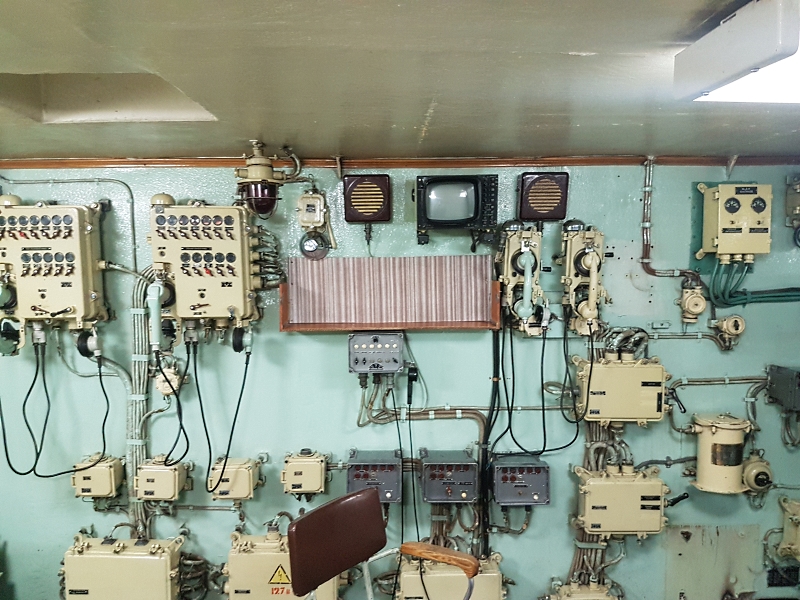
Reference information on the ship, necessary in work. On the icebreaker there are ballast tanks in order to better break through the ice. Lenin can break the ice up to 2 meters thick, modern icebreakers have increased this parameter to 3 meters. But still, not always the icebreaker can sail in any desired direction. Ice reconnaissance and understanding of the weather is always necessary, so that the forces of nature help, and not interfere. There is even a common expression “the best icebreaker is the wind.”
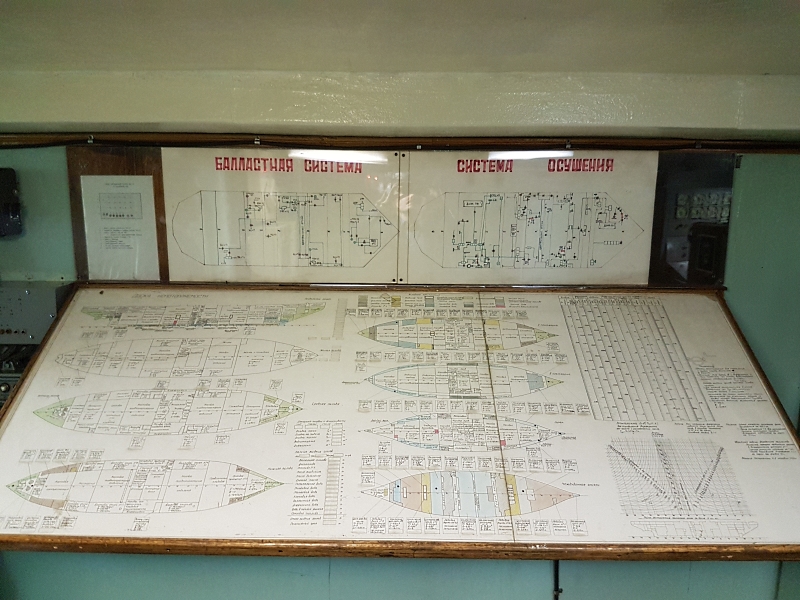
Layout of a nuclear reactor. On the "Lenin" were water-cooled reactors (according to the foreign PWR classification). For thirty years of operation, there have been no serious accidents and no injuries.

The fuel assembly is a cassette with rods with nuclear fuel, most likely from OK-150 (thanks tnenergy for the consultation). When the reactor is started up, the chain reaction generates a lot of heat, which is carried away by the water of the primary circuit. It then transfers heat to the secondary circuit water in the steam generator. The resulting steam turns turbines. Then, through the third circuit, heat is transferred to the environment — in the fourth circuit, already sea water.
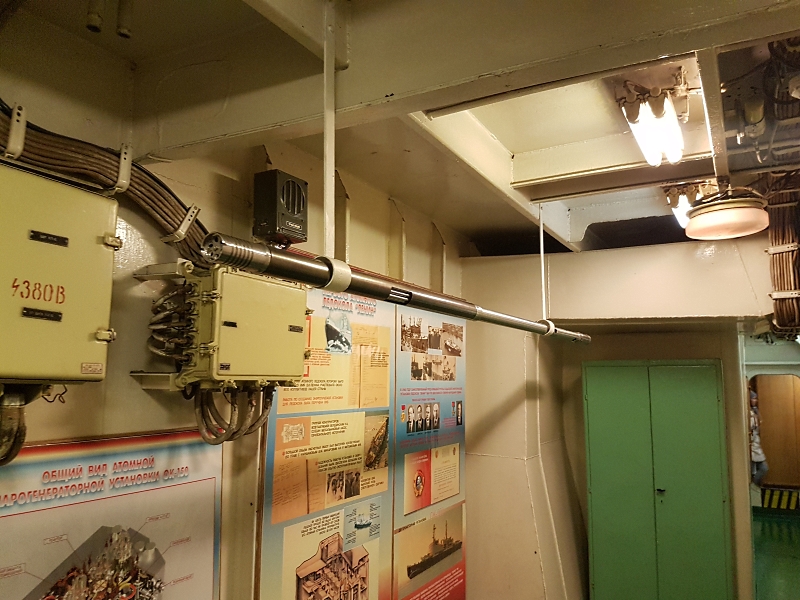
Fuel elements (TVELs) inside the cassette.
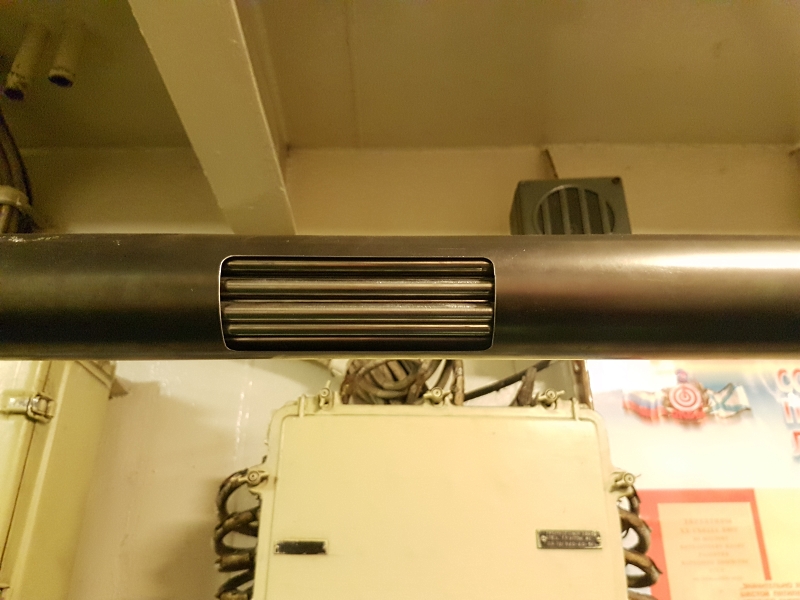
Upper part of the reactor compartment. The reactor itself is no longer there, nuclear fuel is unloaded, the casing is filled with a special compound, similar in consistency to bitumen, and flooded. In the reactor compartment, the watch was not kept, and the mannequins depict an episodic visit to inspect and carry out work.

The bridge. Curiously, despite the solid 16,000 tons of displacement, the ship does not seem huge at all.

View forward along the longitudinal axis of the ship.
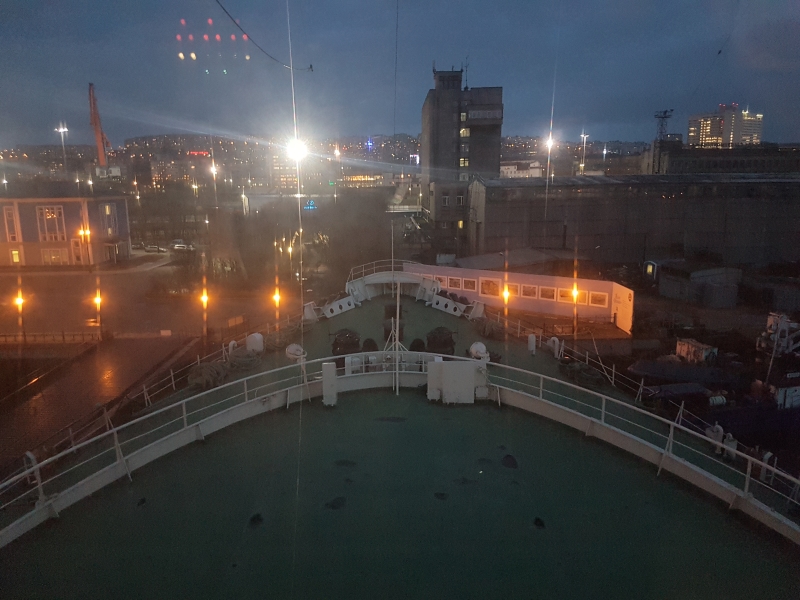
Steering wheel.
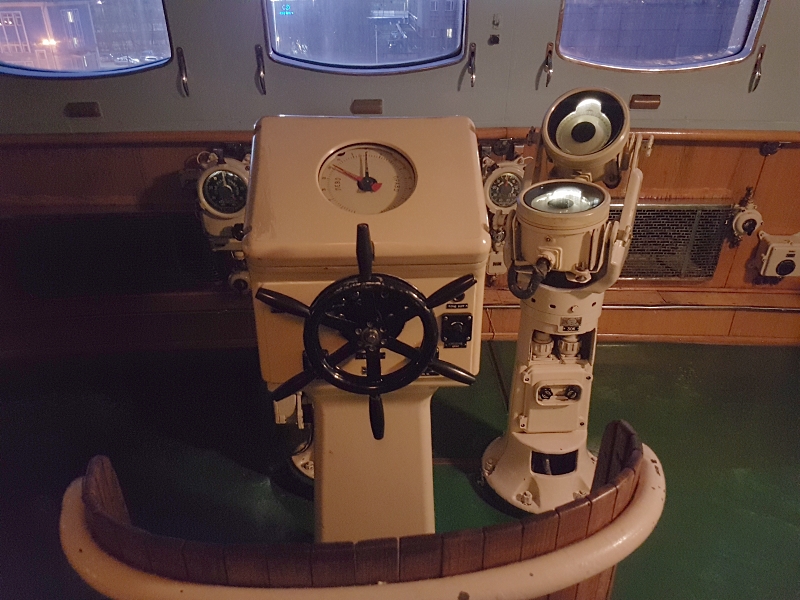
Machine telegraph. There are several of them on the bridge, the movement of the control knobs of one was repeated on the others.

The premises of ICAE on the icebreaker "Lenin" is located on the site of the helicopter hangar, but it is highly modified. By the way, on this trip, for the first time after the lecture, I was asked whether the Earth was flat. At least in the near future it will be a frequent question.

I express my heartfelt gratitude to the staff of the Murmansk Atomic Energy Information Center for the excellent organization of the trip.

Nuclear icebreaker "Lenin"
After 30 years of operation and 563 thousand miles traveled by the first atomic icebreaker (and the first surface ship with a nuclear power plant), the corps has worn out, and now it works as a floating museum.

On the right, by the way, there is also an unusual ship — the Western Neptune bought by Sevmorneftegeofizika, a seismic surveyor and a research vessel.

The icebreaker was built at a fantastically fast pace — laid in 1956, launched in 1957, and in 1959 it went to sea trials. Despite this, they managed to find the resources and time for an excellent finish from noble ship materials - wood, copper, brass.


The panel in the mess room of the officer corps displays milestones in the development of the Arctic. From left to right, the Pomorsky Koch , the first icebreaker of the Russian Empire and the world , Yermak and recursion as an image of Lenin.

The entrance to the mess room, on the sides of the photos of celebrities who visited the ship. Yuri Gagarin and Fidel Castro are clearly distinguishable. Sixty years ago, the first nuclear-powered icebreaker was the same business card of the country, like space.

The officers cabin is located on the sides of two salons. One is a unique piano, specially created for the ship.

The second salon, a bright spot on the floor - mounting for furniture, so as not to leave when rolling.

Cabin chief mechanic. Even now it is impressive, but then it was a fantastic luxury. To the right is the passage to the bedroom, the cabin looks like a two-room apartment. Cabins simple sailors were single and double, also improved habitability.

Salon captain, the third "room".

Panorama cabin mess of the composition. Concurrently served as a dining room and cinema. Located under the officers saloon. Below is a galley, all three rooms are connected by a kitchen lift.

Go to the technique. Engine room. Black - turbine housing, in front of him two generators. For greater reliability, the icebreaker has two engine rooms, in front of and behind the reactor compartment.

Turbine with the cover removed. In total, there are four turbogenerators on the icebreaker with a total power of 32.4 MW, two in the engine room, each turbogenerator consists of one turbine and two generators. But the number of screws and electric motors for them was odd - three pieces each. In addition, there were backup and emergency generators on liquid fuel.

And this is how a working engine room sounds (audio from another atomic icebreaker is played).
Jobs post energy and vitality, the "brain" of the icebreaker. Right mnemonic control reactor.

Mimic diagram of the reactor more close-up. Initially, there were three OK-150 units with a capacity of 90 MW on Lenin, then, due to their low maintainability, they were replaced with two OK-900 reactors with a capacity of 159 MW each (171 MW can be found on the Internet, but it belongs to the OK-900A reactor icebreakers "Arctic", "Siberia", "Russia").

Communication equipment and a screen showing the image from the chamber in the reactor compartment.

Reference information on the ship, necessary in work. On the icebreaker there are ballast tanks in order to better break through the ice. Lenin can break the ice up to 2 meters thick, modern icebreakers have increased this parameter to 3 meters. But still, not always the icebreaker can sail in any desired direction. Ice reconnaissance and understanding of the weather is always necessary, so that the forces of nature help, and not interfere. There is even a common expression “the best icebreaker is the wind.”

Layout of a nuclear reactor. On the "Lenin" were water-cooled reactors (according to the foreign PWR classification). For thirty years of operation, there have been no serious accidents and no injuries.

The fuel assembly is a cassette with rods with nuclear fuel, most likely from OK-150 (thanks tnenergy for the consultation). When the reactor is started up, the chain reaction generates a lot of heat, which is carried away by the water of the primary circuit. It then transfers heat to the secondary circuit water in the steam generator. The resulting steam turns turbines. Then, through the third circuit, heat is transferred to the environment — in the fourth circuit, already sea water.

Fuel elements (TVELs) inside the cassette.

Upper part of the reactor compartment. The reactor itself is no longer there, nuclear fuel is unloaded, the casing is filled with a special compound, similar in consistency to bitumen, and flooded. In the reactor compartment, the watch was not kept, and the mannequins depict an episodic visit to inspect and carry out work.

The bridge. Curiously, despite the solid 16,000 tons of displacement, the ship does not seem huge at all.

View forward along the longitudinal axis of the ship.

Steering wheel.

Machine telegraph. There are several of them on the bridge, the movement of the control knobs of one was repeated on the others.

The premises of ICAE on the icebreaker "Lenin" is located on the site of the helicopter hangar, but it is highly modified. By the way, on this trip, for the first time after the lecture, I was asked whether the Earth was flat. At least in the near future it will be a frequent question.

Bonus Northern Fleet Naval Museum
The museum as a whole is interesting, but unfortunately firmly stuck in the last century. Models, paintings, exhibits, photographs and text, and no interactivity. The models are very beautiful, but, alas, they cannot be twisted and touched, so that computer models already benefit both in appearance and in interactivity.
Model icebreaker "Lenin". Valuable opportunity to see rather big underwater part.

Typical picture.

Headgear and ribbon to visor from the cruiser "Varyag".
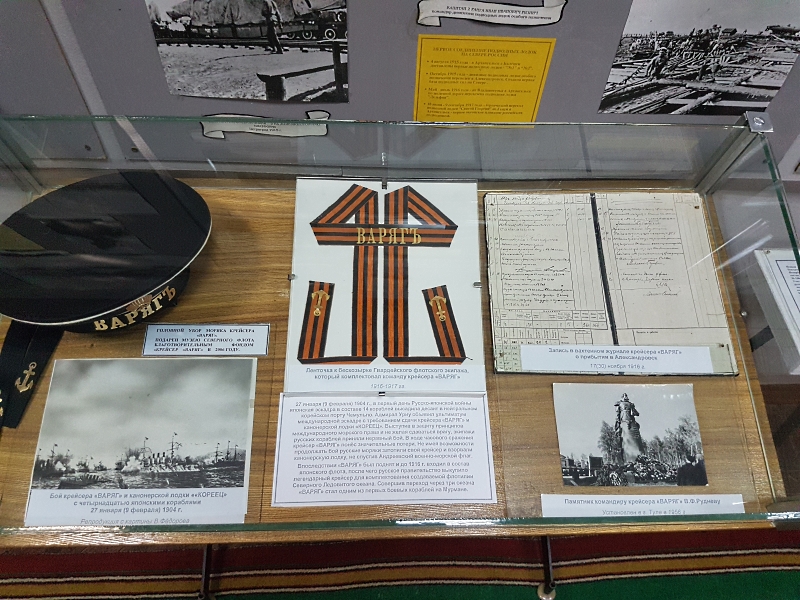
"Trilinek" Mosin in the section.
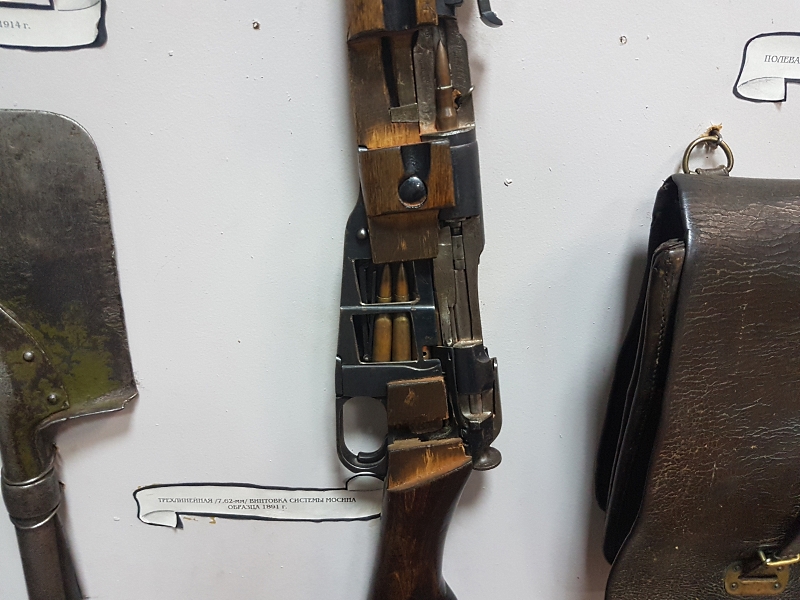
Details from the ships.
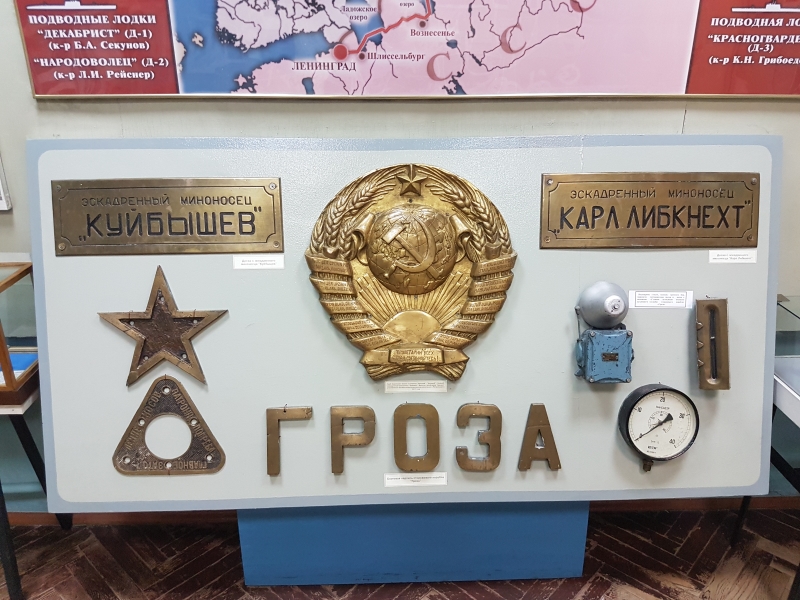
Sniper cigarette case 63 Abbasov Marine Corps brigade
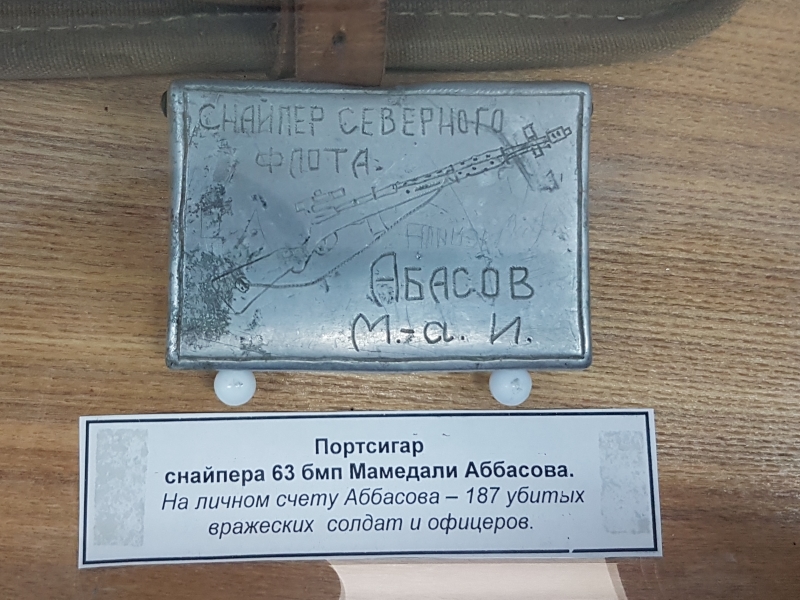
Devices from a K-21 submarine attacking the German battleship Tirpitz.

Some exhibits make you smile.
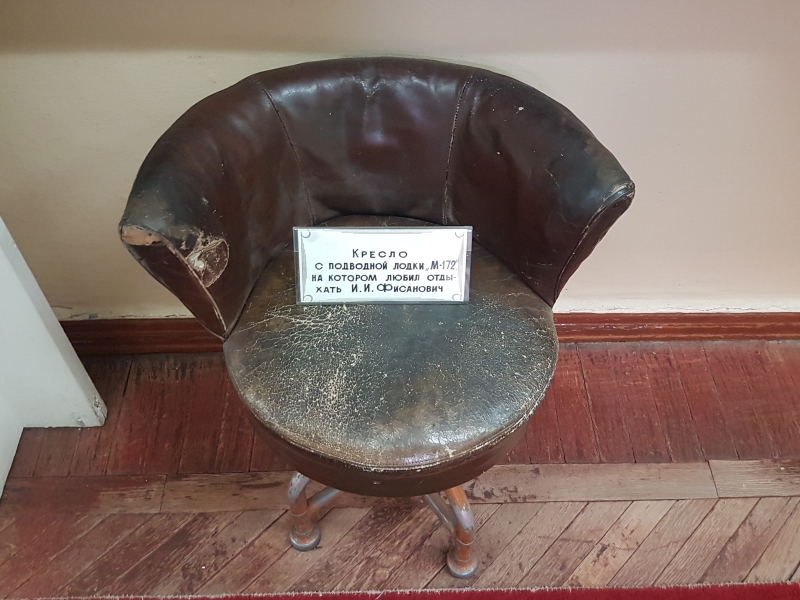
Very unusual tube.

Big green rocket - R-11FM, the first ballistic missile for submarines. The wreckage below the U-2 Powers aircraft shot down on May 1, 1960.

Yuri Gagarin served as a fighter pilot in the Northern Fleet, so it is not surprising that there are artifacts associated with him in the museum. The photo shows the parachute and the packing form.

Gagarin's book with a dedication, donated to the museum October 23, 1961.
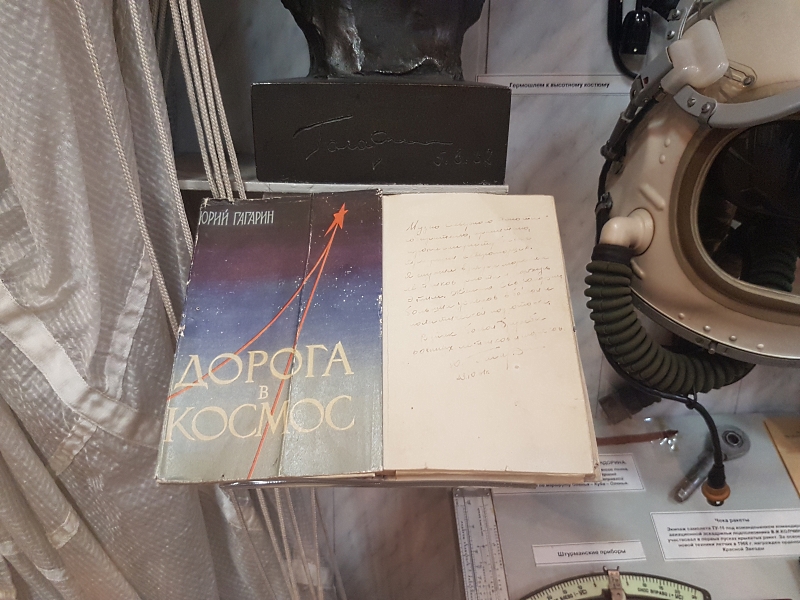
A few more models from the set.
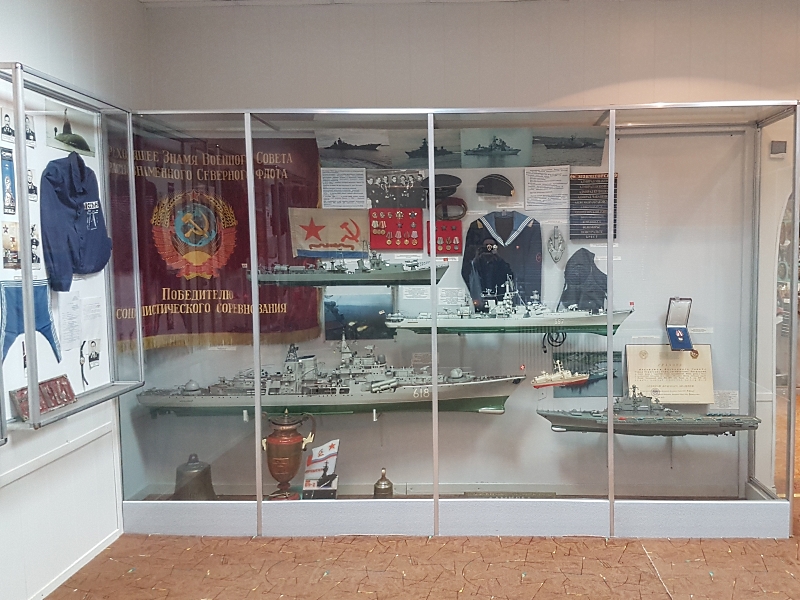
The museum is very correct attitude to disasters. They are remembered, but without hysteria, "to which everyone brought everything." This exhibit caused the biggest emotional response in me - the book “Following the Footsteps of Underwater Disasters”, discovered after lifting the dead Kursk boat in the cabin of Alexander Shubin, deputy commander for educational work. Such a book could not have a person indifferent about their work.

Not a very common exhibit - captured German anti-tank gun PaK-35/36. In the background, the anchor mine and anti-submarine bombardment shell.

Northern Fleet Naval Museum
The museum as a whole is interesting, but unfortunately firmly stuck in the last century. Models, paintings, exhibits, photographs and text, and no interactivity. The models are very beautiful, but, alas, they cannot be twisted and touched, so that computer models already benefit both in appearance and in interactivity.
Model icebreaker "Lenin". Valuable opportunity to see rather big underwater part.

Typical picture.

Headgear and ribbon to visor from the cruiser "Varyag".

"Trilinek" Mosin in the section.

Details from the ships.

Sniper cigarette case 63 Abbasov Marine Corps brigade

Devices from a K-21 submarine attacking the German battleship Tirpitz.

Some exhibits make you smile.

Very unusual tube.

Big green rocket - R-11FM, the first ballistic missile for submarines. The wreckage below the U-2 Powers aircraft shot down on May 1, 1960.

Yuri Gagarin served as a fighter pilot in the Northern Fleet, so it is not surprising that there are artifacts associated with him in the museum. The photo shows the parachute and the packing form.

Gagarin's book with a dedication, donated to the museum October 23, 1961.

A few more models from the set.

The museum is very correct attitude to disasters. They are remembered, but without hysteria, "to which everyone brought everything." This exhibit caused the biggest emotional response in me - the book “Following the Footsteps of Underwater Disasters”, discovered after lifting the dead Kursk boat in the cabin of Alexander Shubin, deputy commander for educational work. Such a book could not have a person indifferent about their work.

Not a very common exhibit - captured German anti-tank gun PaK-35/36. In the background, the anchor mine and anti-submarine bombardment shell.

I express my heartfelt gratitude to the staff of the Murmansk Atomic Energy Information Center for the excellent organization of the trip.
All Articles